Change in Hydrogen Trapping Characteristics and Influence on Hydrogen Embrittlement Sensitivity in a Medium-Carbon, High-Strength Steel: The Effects of Heat Treatments
Abstract
1. Introduction
2. Materials and Methods
3. Results
3.1. Hydrogen Embrittlement Susceptibility
3.2. Microstructure Characterization
3.3. Hydrogen Permeation and Hydrogen Trapping Sites
3.4. HE Fracture Surface Characteristics
4. Discussion
4.1. Hydrogen Trapping and Diffusion
4.2. Hydrogen Embrittlement Mechanism
5. Conclusions
- (1)
- After the N&T and Q&T heat treatments, both the NT and QT samples were found to have dislocations, grain boundaries, and carbides as hydrogen traps. The dislocation density was 9.84 and 14.11 × 1014/m2, and the volume fraction of the HAGBs was 11.7% and 29.98%, respectively. The carbides in the NT sample were distributed at the PAGBs and prior MA interface with a larger size, and the fine carbides in the QT sample were distributed dispersedly at the interface of the PAGBs and prior martensite lath interface.
- (2)
- Through TDS and deconvolution analysis, the hydrogen concentrations trapped by dislocations, interfaces, and carbides in the NT and QT samples were 1.05/1.22, 0.68/0.76, and 0.33/0.38 wppm, respectively. And the hydrogen diffusion coefficients in the NT and QT samples were confirmed to be 0.968 × 10−7 and 1.880 × 10−7 cm2/s, respectively.
- (3)
- The HE susceptibility of the NT and QT samples were 66.80% and 54.64%, respectively. Compared with the NT sample, the QT sampled had a lower hydrogen embrittlement sensitivity. The dispersed and fine carbide distribution, as well as the greater number of martensite lath interfaces in the QT sample, contributed to a relatively lower susceptibility to hydrogen embrittlement.
Author Contributions
Funding
Institutional Review Board Statement
Informed Consent Statement
Data Availability Statement
Conflicts of Interest
References
- Qadrdan, M.; Abeysekera, M.; Wu, N.J.; Jenkins, B. Winter. In The Future of Gas Networks; Springer: Cham, Switzerland, 2020. [Google Scholar]
- Fuel Cells and Hydrogen Joint Undertaking. Hydrogen Roadmap Europe: A Sustainable Pathway for the European Energy Transition. 2019. Available online: https://www.h2knowledgecentre.com/content/researchpaper1125 (accessed on 14 April 2024).
- Androulaki, M. Towards an EU Hydrogen Economy: Policy and Energy Security Perspectives. 2020. Available online: https://policycommons.net/artifacts/2026247/towards-an-eu-hydrogen-economy/2778690/ (accessed on 14 April 2024).
- German site for Enapter electrolyser production. Fuel Cells Bull. 2020, 2020, 12. [CrossRef]
- Thomas, S.; Ott, N.R.F.; Schaller Yuwono, J.A.; Volovitch, P.; Sundararajan, G.; Medhekar, N.V.; Ogle, K.; Scully, J.R.; Birbilis, N. The effect of absorbed hydrogen on the dissolution of steel. Heliyon 2016, 2, 209. [Google Scholar] [CrossRef] [PubMed]
- Oriani, R.A. Hydrogen-The Versatile Embrittler. Corrosion 1987, 43, 390–397. [Google Scholar] [CrossRef]
- Robertson, I.M.; Sofronis, P.; Nagao, A.; Martin, M.L.; Wang, S.; Gross, D.W.; Nygren, K.E. Hydrogen embrittlement understood. Metall. Mater. Trans. A 2015, 46, 2323–2341. [Google Scholar] [CrossRef]
- Han, Y.D.; Wang, R.Z.; Wang, H.; Xu, L.Y. Hydrogen embrittlement sensitivity of X100 pipeline steel under different pre-strain. Int. J. Hydrogen Energy 2019, 44, 22380–22393. [Google Scholar] [CrossRef]
- Al-Mansour, M.; Alfantazi, A.M.; El-boujdaini, M. Sulfide stress cracking resistance of API-X100 high strength low alloy steel. Mater. Design 2009, 30, 4088–4094. [Google Scholar] [CrossRef]
- Dong, C.F.; Liu, Z.Y.; Li, X.G.; Cheng, Y.F. Effects of hydrogen-charging on the susceptibility of X100 pipeline steel to hydrogen-induced cracking. Int. J. Hydrogen Energy 2009, 34, 9879–9884. [Google Scholar] [CrossRef]
- Nanninga, N.E.; Levy, Y.S.; Drexler, E.S.; Condon, R.T.; Stevenson, A.E.; Slifka, A.J. Comparison of hydrogen embrittlement in three pipeline steels in high pressure gaseous hydrogen environments. Corros. Sci. 2012, 59, 1–9. [Google Scholar] [CrossRef]
- Cauwels, M.; Claeys, L.; Depover, T.; Verbeken, K. The hydrogen embrittlement sensitivity of duplex stainless steel with different phase fractions evaluated by in-situ mechanical testing. Frat. Integrità Strutt. 2020, 14, 449–458. [Google Scholar] [CrossRef]
- McCarty, E.D.; Wetzel, D.; Kloberdanz, B.S. Hydrogen Embrittlement in Automotive Fastener Applications; Technical Paper Series, No. 960312; SAE International: Warrendale, PA, USA, 1996. [Google Scholar]
- Nakasato, F. Delayed fracture of bolts. Tetsu-Hagané 2002, 22, 606–611. [Google Scholar] [CrossRef][Green Version]
- Wang, M.; Akiyama, E.; Tsuzaki, K. Determination of the critical hydrogen concentration for delayed fracture of high strength steel by constant load test and numerical calculation. Corros. Sci. 2006, 48, 2189–2202. [Google Scholar] [CrossRef]
- Ohaeri, E.; Eduok, U.; Szpunar, J. Hydrogen related degradation in pipeline steel: A. review. Int. J. Hydrogen Energy 2018, 43, 14584–14617. [Google Scholar] [CrossRef]
- Haq, A.J.; Muzaka, K.; Dunne, D.P.; Calka, A.; Pereloma, E.V. Effect of microstructure and composition on hydrogen permeation in X70 pipeline steels. J. Hydrogen Energy 2013, 38, 2544–2556. [Google Scholar] [CrossRef]
- Dwivedi, S.K.; Vishwakarma, M. Effect of hydrogen in advanced high strength steel materials. Int. J. Hydrogen Energy 2019, 44, 28007–28030. [Google Scholar] [CrossRef]
- McMahon, C.J. Hydrogen-induced intergranular fracture of steels. Eng. Fract. Mech. 2001, 68, 773–788. [Google Scholar] [CrossRef]
- Dietzel, W.; Atrens, A.; Barnoush, A. Mechanics of modern test methods and quantitative-accelerated testing for hydrogen embrittlement. In Gaseous Hydrogen Embrittlement of Materials in Energy Technologies; Woodhead Publishing: Sawston, UK, 2012; pp. 237–273. [Google Scholar]
- Kappes, M.; Iannuzzi, M.; Carranza, R.M. Hydrogen Embrittlement of Magnesium and Magnesium Alloys: A Review. J. Electrochem. Soc. 2013, 160, C168–C178. [Google Scholar] [CrossRef]
- Lynch, S.P. Mechanisms of hydrogen assisted cracking—A review. In Proceedings of the International Conference on Hydrogen Effects on Material Behaviour and Corrosion Deformation Interactions, Moran, WY, USA, January 2003. [Google Scholar]
- Tong, Z.; Zhou, G.; Zheng, W.; Zhang, H.; Zhou, H.; Sun, X. Effects of Heat Treatment on the Microstructure and Mechanical Properties of a Novel H-Grade Sucker Rod Steel. Metals 2022, 12, 294. [Google Scholar] [CrossRef]
- Imdad, A.; Arniella, V.; Zafra, A.; Belzunce, J. Tensile behaviour of 42CrMo4 steel submitted to annealed, normalized, and quench and tempering heat treatments with in-situ hydrogen charging. Int. J. Hydrogen Energy 2024, 50, 270–280. [Google Scholar] [CrossRef]
- Zhou, H.; Sun, X.; Tong, Z.; Cheng, G.; Xu, B.; Xiao, X.; Wang, Q.; Ran, M.; Ding, H.; Zheng, W.; et al. Effects of tempering temperature on the precipitation behaviors of nanoparticles and their influences on the susceptibility to hydrogen embrittlement of a Cr–Mo–V steel. Int. J. Hydrogen Energy 2023, 50, 254–269. [Google Scholar] [CrossRef]
- Devanathan, M.A.V.; Stachurski, Z. The Mechanism of Hydrogen Evolution on Iron in Acid Solutions by Determination of Permeation Rates. J. Electrochem. Soc. 1964, 111, 619. [Google Scholar] [CrossRef]
- Cardenas, A.L.; Silva, R.O.; Eckstein, C.B.; Dos Santos, D.S. Hydrogen effect on 2.25Cr–1Mo–0.25V bainitic steel under aging heat treatment. Int. J. Hydrogen Energy 2018, 43, 16400–16410. [Google Scholar] [CrossRef]
- Fan, Y.H.; Zhang, B.; Yi, H.L.; Hao, G.S.; Sun, Y.Y.; Wang, J.Q.; Han, E.H.; Ke, W. The role of reversed austenite in hydrogen embrittlement fracture of S41500 martensitic stainless steel. Acta Mater. 2017, 139, 188–195. [Google Scholar] [CrossRef]
- Hui, W.; Zhang, H.; Zhang, Y.; Zhao, X.; Shao, C. Effect of nickel on hydrogen embrittlement behavior of medium-carbon high strength steels. Mat. Sci. Eng. A 2016, 674, 615–625. [Google Scholar] [CrossRef]
- Moussa, C.; Bernacki, M.; Besnard, R.; Bozzolo, N. About quantitative EBSD analysis of deformation and recovery substructures in pure Tantalum. In IOP Conference Series: Materials Science and Engineering; IOP Publishing: Bristol, UK, 2015; Volume 89, p. 12038. [Google Scholar]
- Xue, H.B.; Cheng, Y.F. Characterization of inclusions of X80 pipeline steel and its correlation with hydrogen-induced cracking. Corros. Sci. 2011, 53, 1201–1208. [Google Scholar] [CrossRef]
- Cheng, Y. Analysis of electrochemical hydrogen permeation through X-65 pipeline steel and its implications on pipeline stress corrosion cracking. Int. J. Hydrogen Energy 2007, 32, 1269–1276. [Google Scholar] [CrossRef]
- Banerjee, K.U.K. Chatterjee, Hydrogen permeation and hydrogen content under cathodic charging in HSLA 80 and HSLA 100 steels. Scripta Mater. 2001, 44, 213–216. [Google Scholar] [CrossRef]
- Pressouyre, G.M. A classification of hydrogen traps in steel. Metall. Trans. A 1979, 10, 1571–1573. [Google Scholar] [CrossRef]
- Venezuela, J.; Gray, E.; Liu, Q.; Zhou, Q.; Tapia-Bastidas, C.; Zhang, M.; Atrens, A. Equivalent hydrogen fugacity during electrochemical charging of some martensitic advanced high-strength steels. Corros. Sci. 2017, 127, 45–58. [Google Scholar] [CrossRef]
- Gong, P.; Turk, A.; Nutter, J.; Yu, F.; Wynne, B.; Rivera-Diaz-del-Castillo, P.; Mark Rainforth, W. Hydrogen embrittlement mechanisms in advanced high strength steel. Acta Mater. 2022, 223, 117488. [Google Scholar] [CrossRef]
- Drexler, A.; Depover, T.; Leitner, S.; Verbeken, K.; Ecker, W. Microstructural based hydrogen diffusion and trapping models applied to Fe–C X alloys. J. Alloys Compd. 2020, 826, 154057. [Google Scholar] [CrossRef]
- Yoo, J.; Jo, M.C.; Kim, S.; Oh, J.; Bian, J.; Sohn, S.S.; Lee, S. Effects of Ti alloying on resistance to hydrogen embrittlement in (Nb+Mo)-alloyed ultra-high-strength hot-stamping steels. Mater. Sci. Eng. A 2020, 791, 139763. [Google Scholar] [CrossRef]
- Wei, F.G.; Hara, T.; Tsuzaki, K. Precise determination of the activation energy for desorption of hydrogen in two Ti-added steels by a single thermal-desorption spectrum. Metall. Mater. Trans. B 2004, 35, 587–597. [Google Scholar] [CrossRef]
- Nagao, A.; Dadfarnia, M.; Somerday, B.P.; Sofronis, P.; Ritchie, R.O. Hydrogen-enhanced-plasticity mediated decohesion for hydrogen-induced intergranular and “quasi-cleavage” fracture of lath martensitic steels. J. Mech. Phys. Solids 2018, 112, 403–430. [Google Scholar] [CrossRef]
- Zhou, C.; Ye, B.; Song, Y.; Cui, T.; Xu, P.; Zhang, L. Effects of internal hydrogen and surface-absorbed hydrogen on the hydrogen embrittlement of X80 pipeline steel. Int. J. Hydrogen Energy 2019, 44, 22547–22558. [Google Scholar] [CrossRef]
- Depover, T.; Verbeken, K. The detrimental effect of hydrogen at dislocations on the hydrogen embrittlement susceptibility of Fe-C-X alloys: An experimental proof of the HELP mechanism. Int. J. Hydrogen Energy 2018, 43, 3050–3061. [Google Scholar] [CrossRef]
- Hirth, J.P. Effects of hydrogen on the properties of iron and steel. Metal. Trans. A 1980, 11, 861–890. [Google Scholar] [CrossRef]
- Turk, A.; Joshi, G.R.; Gintalas, M.; Callisti, M.; Rivera-Díaz-del-Castillo, P.E.J.; Galindo-Nava, E.I. Quantification of hydrogen trapping in multiphase steels: Part I—Point traps in martensit. Acta Mater. 2020, 194, 118–133. [Google Scholar] [CrossRef]
- Okano, H.; Takagi, S. Identification of Hydrogen Trapping Sites in a Strained Ferritic-Martensitic Dual-Phase Steel. ISIJ Int. 2019, 59, 1828–1837. [Google Scholar] [CrossRef]
- Depover, T.; Verbeken, K. Evaluation of the effect of V4C3 precipitates on the hydrogen induced mechanical degradation in Fe-C-V alloys. Mater. Sci. Eng. A 2016, 675, 299–313. [Google Scholar] [CrossRef]
- Sakamoto, Y.; Mantani, T. Effect of Quenching and Tempering on Diffusion of Hydrogen in Carbon Steel. Trans. Jpn. Inst. Met. 1976, 17, 743–748. [Google Scholar] [CrossRef]
- Pinson, M.; Springer, H.; Depover, T.; Verbeken, K. The role of cementite on the hydrogen embrittlement mechanism in martensitic medium-carbon steels. Mater. Sci. Eng. A 2022, 859, 144204. [Google Scholar] [CrossRef]
- Nagao, A.; Martin, M.L.; Dadfarnia, M.; Sofronis, P.; Robertson, I.M. The effect of nanosized (Ti,Mo)C precipitates on hydrogen embrittlement of tempered lath martensitic steel. Acta Mater. 2014, 74, 244–254. [Google Scholar] [CrossRef]
- Zhao, N.; Zhao, Q.; He, Y.; Liu, R.; Zheng, W.; Liu, W.; Zhang, Y. Investigation on hydrogen embrittlement susceptibility in martensitic steels with 1000 MPa yield strength. J. Mater. Res. Technol. 2021, 15, 6883–6900. [Google Scholar] [CrossRef]
- McEniry, E.J.; Hickel, T.; Neugebauer, J. Ab initio simulation of hydrogen-induced decohesion in cementite-containing microstructures. Acta Mater. 2018, 150, 53–58. [Google Scholar] [CrossRef]
- Pinson, M.; Springer, H.; Depover, T.; Verbeken, K. Qualification of the in-situ bending technique towards the evaluation of the hydrogen induced fracture mechanism of martensitic Fe–C steels. Mater. Sci. Eng. A 2020, 792, 139754. [Google Scholar] [CrossRef]
- Troiano, A.R. The Role of Hydrogen and Other Interstitials in the Mechanical Behavior of Metals, Metallography. Microstruct. Anal. 2016, 5, 557–569. [Google Scholar] [CrossRef]
- Oriani, R.A. A mechanistic theory of hydrogen embrittlement of steels. Berichte Bunsenges. Phys. Chem. 1972, 76, 848–857. [Google Scholar] [CrossRef]
- Peral, L.B.; Zafra, A.; Fernández-Pariente, I.; Rodríguez, C.; Belzunce, J. Effect of internal hydrogen on the tensile properties of different CrMo(V) steel grades: Influence of vanadium addition on hydrogen trapping and diffusion. Int. J. Hydrogen Energy 2020, 45, 22054–22079. [Google Scholar] [CrossRef]
- Li, X.; Zhang, J.; Akiyama, E.; Wang, Y.; Li, Q. Microstructural and crystallographic study of hydrogen-assisted cracking in high strength PSB1080 steel. Int. J. Hydrogen Energy 2018, 43, 17898–17911. [Google Scholar] [CrossRef]
- Wang, M.; Akiyama, E.; Tsuzaki, K. Effect of hydrogen on the fracture behavior of high strength steel during slow strain rate test. Corros. Sci. 2007, 49, 4081–4097. [Google Scholar] [CrossRef]
- Park, C.; Kang, N.; Liu, S. Effect of grain size on the resistance to hydrogen embrittlement of API 2W Grade 60 steels using in situ slow-strain-rate testing. Corros. Sci. 2017, 128, 33–41. [Google Scholar] [CrossRef]
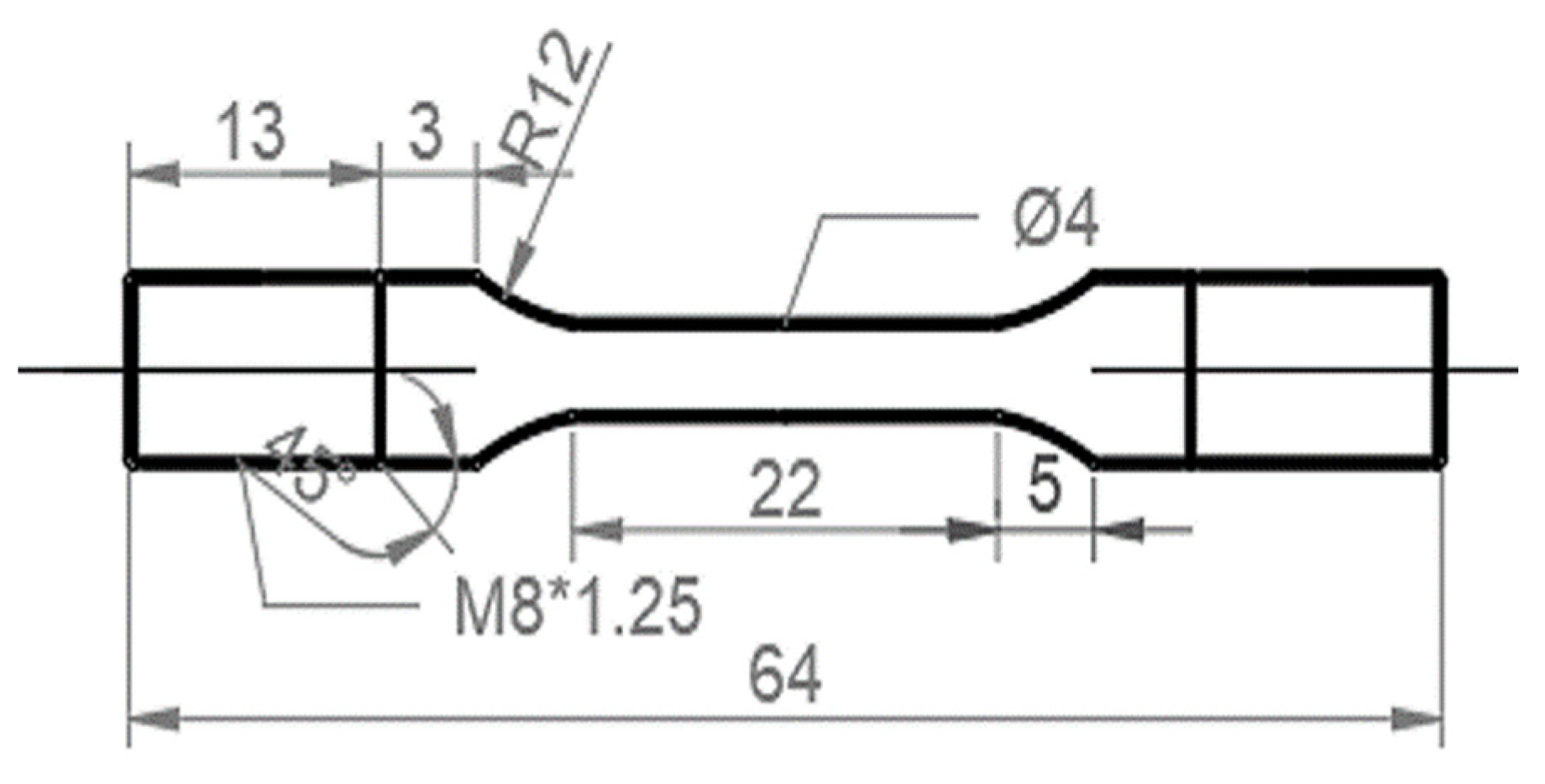

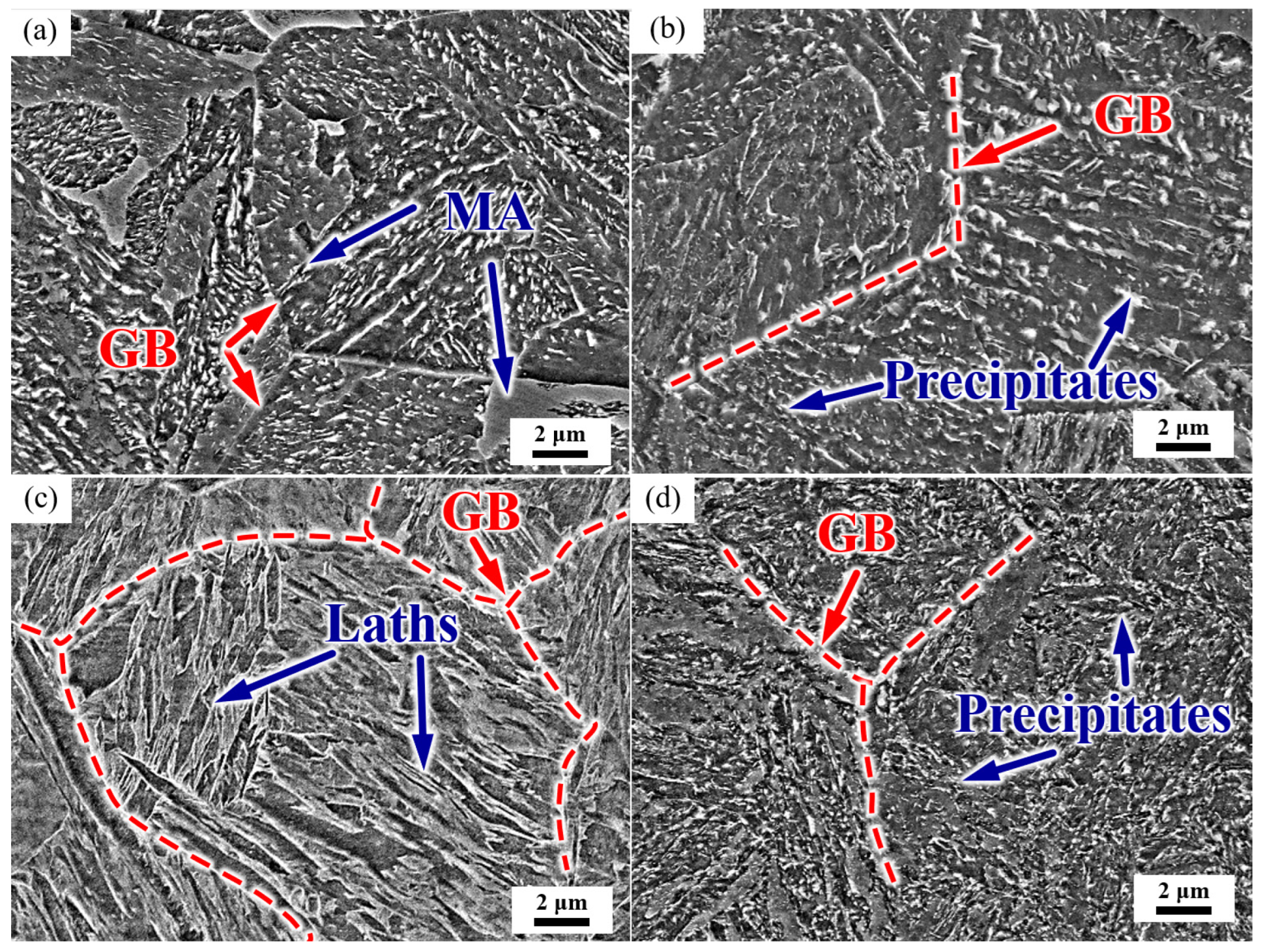
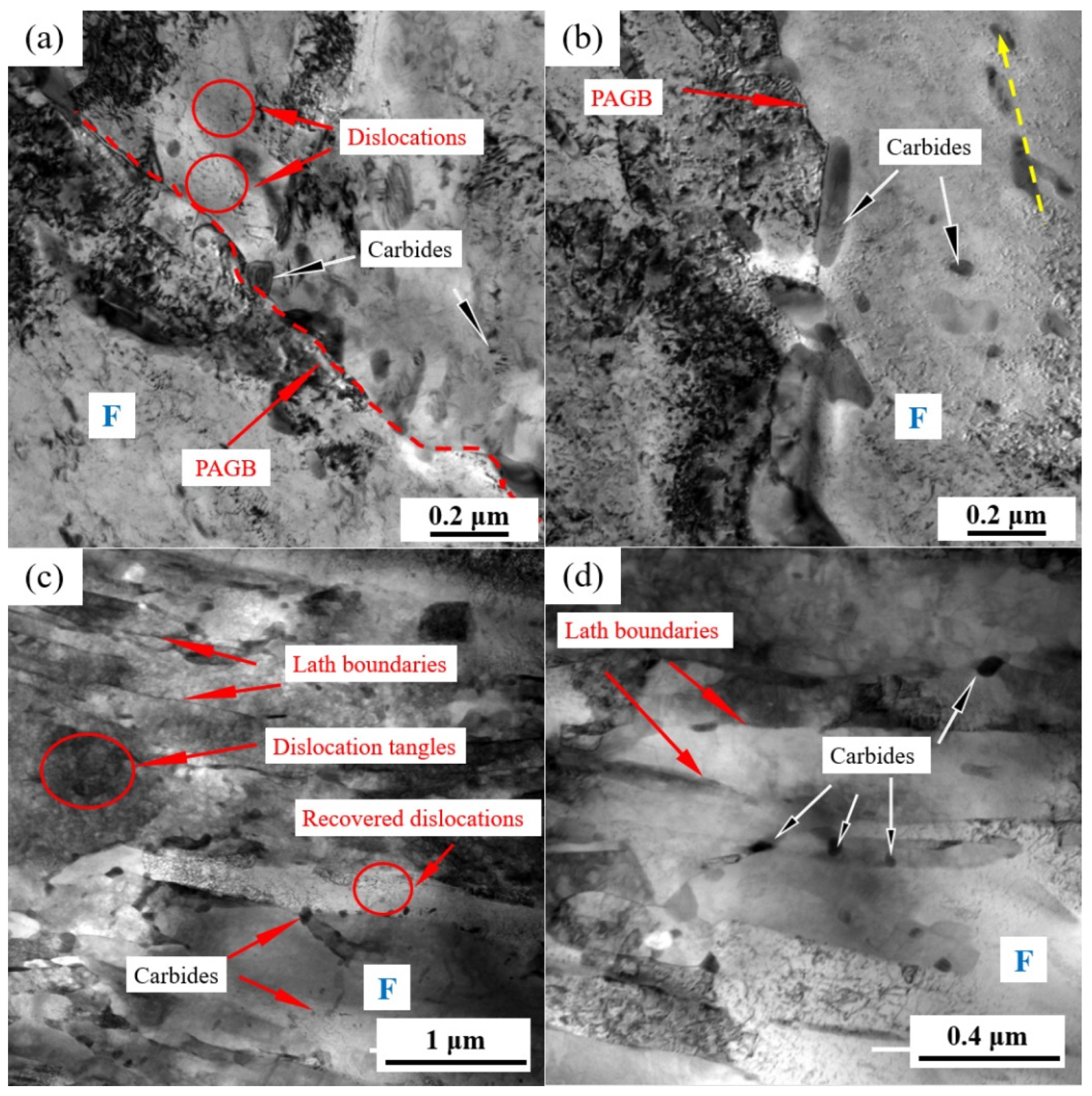
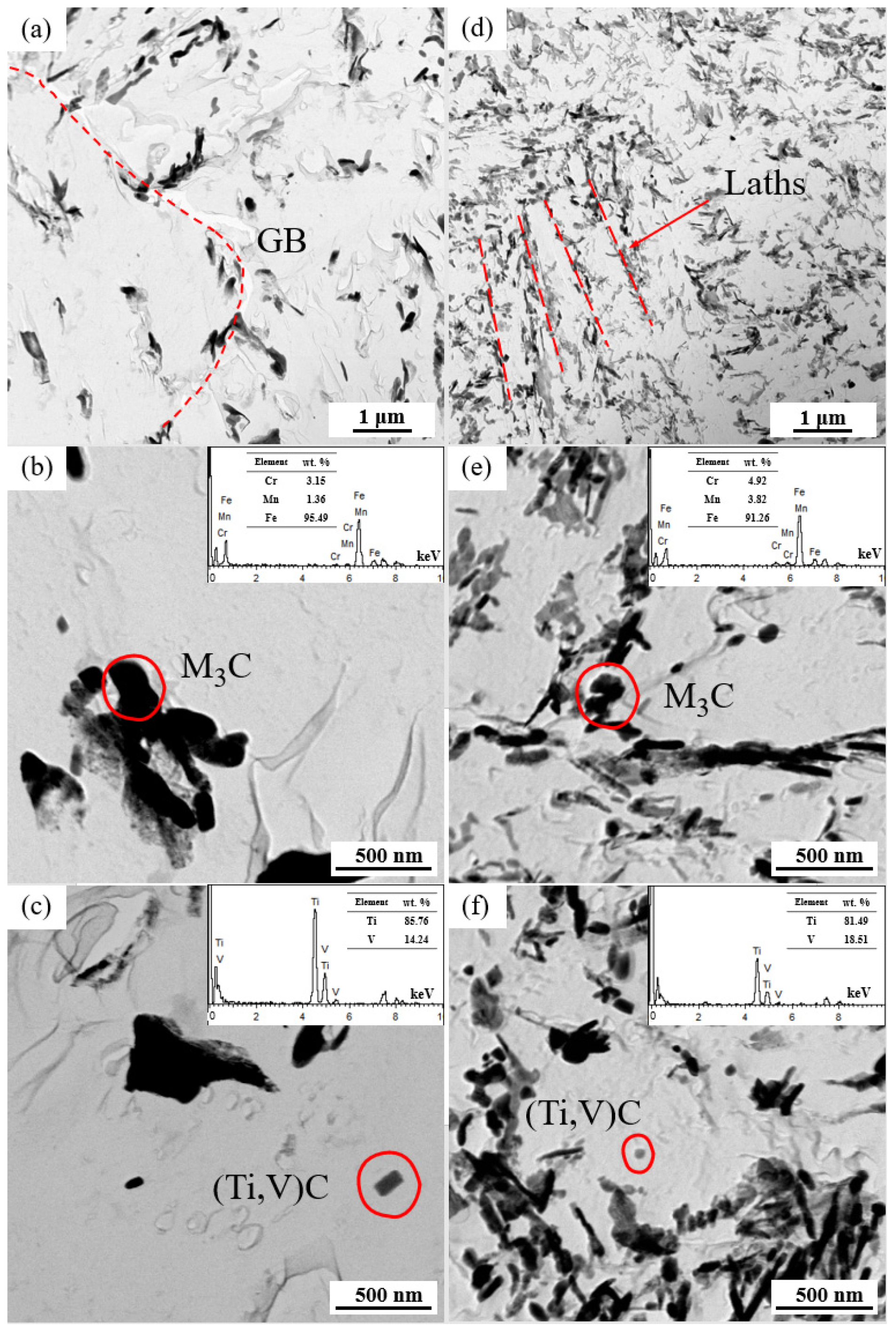
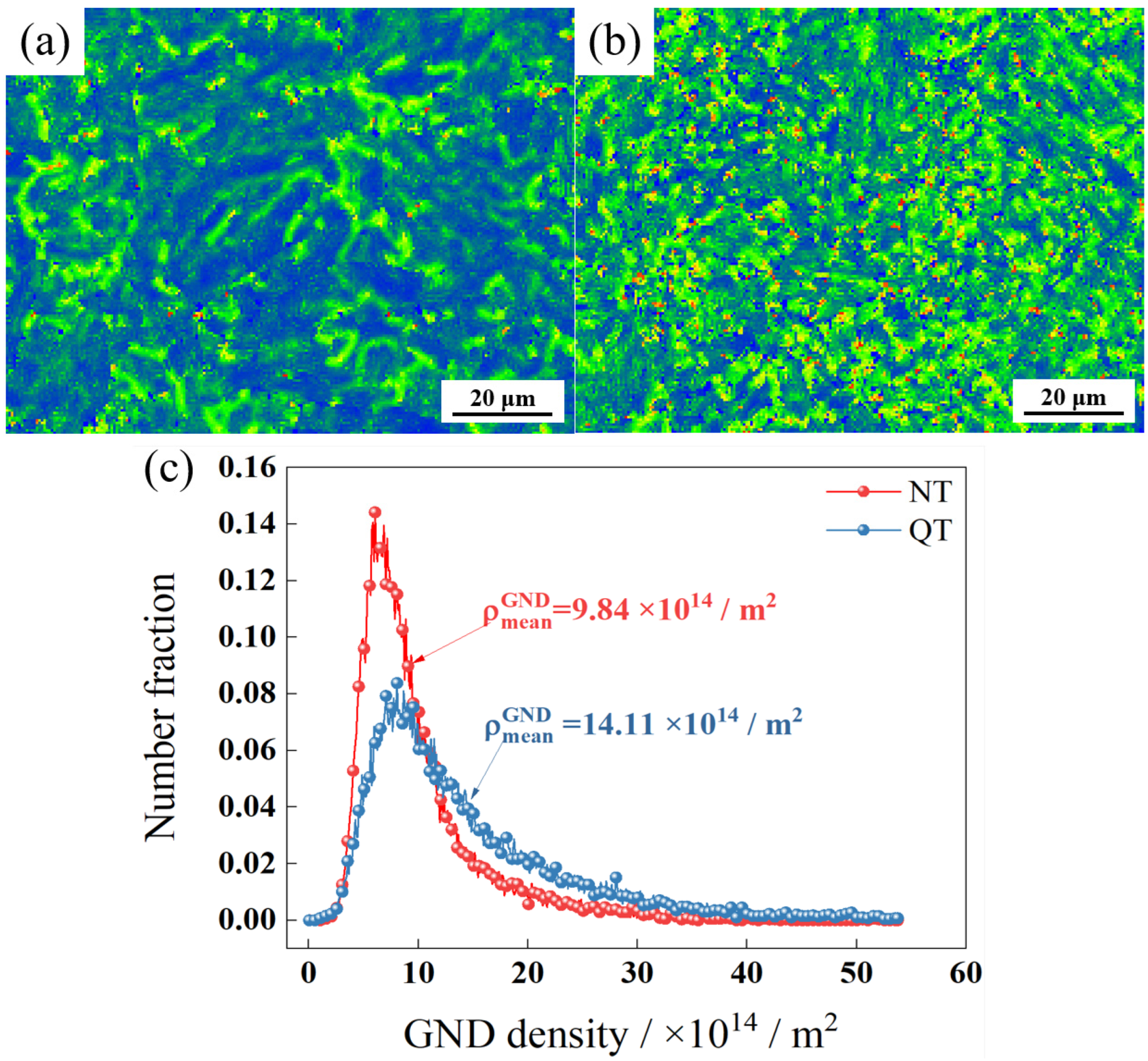
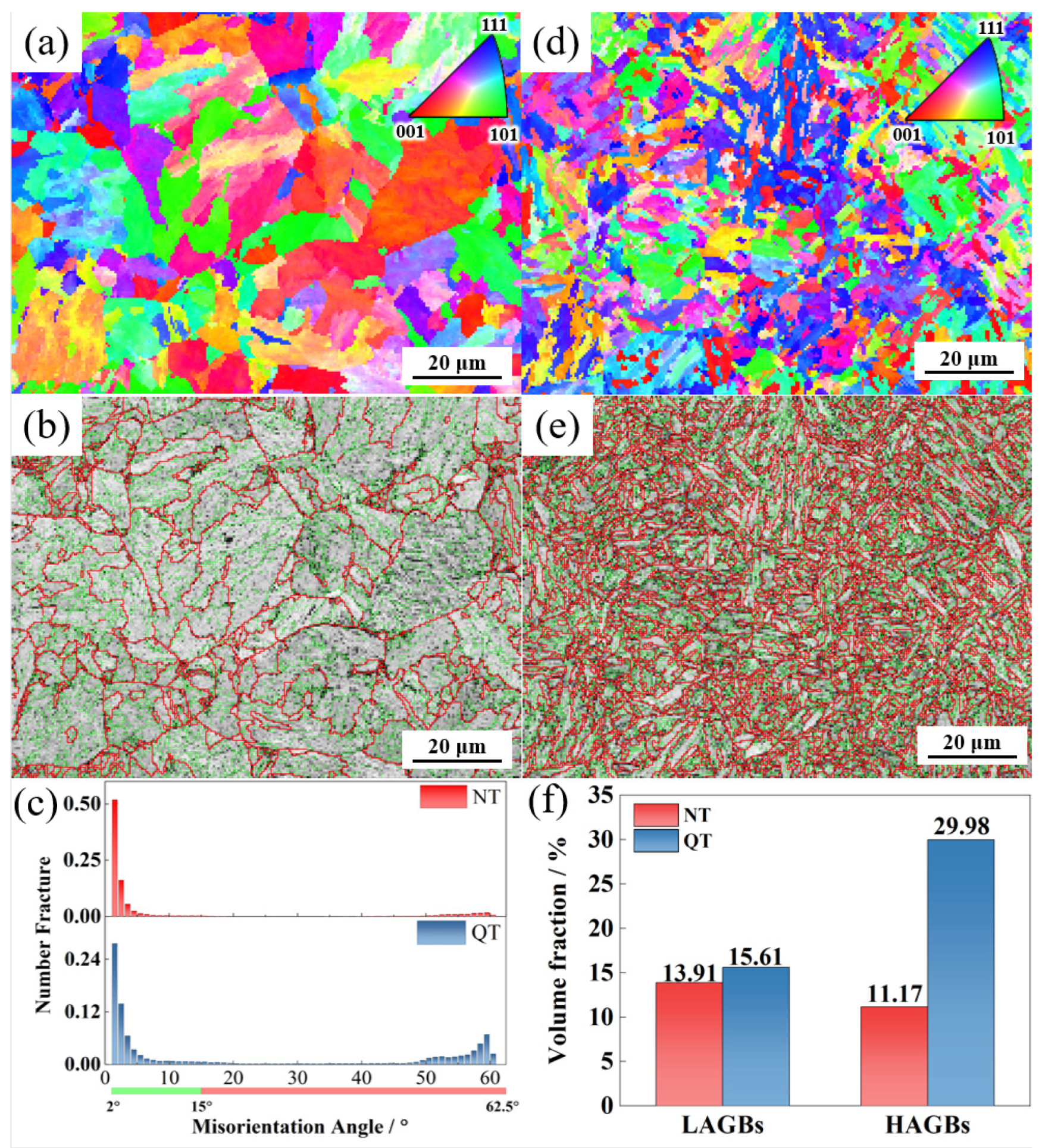

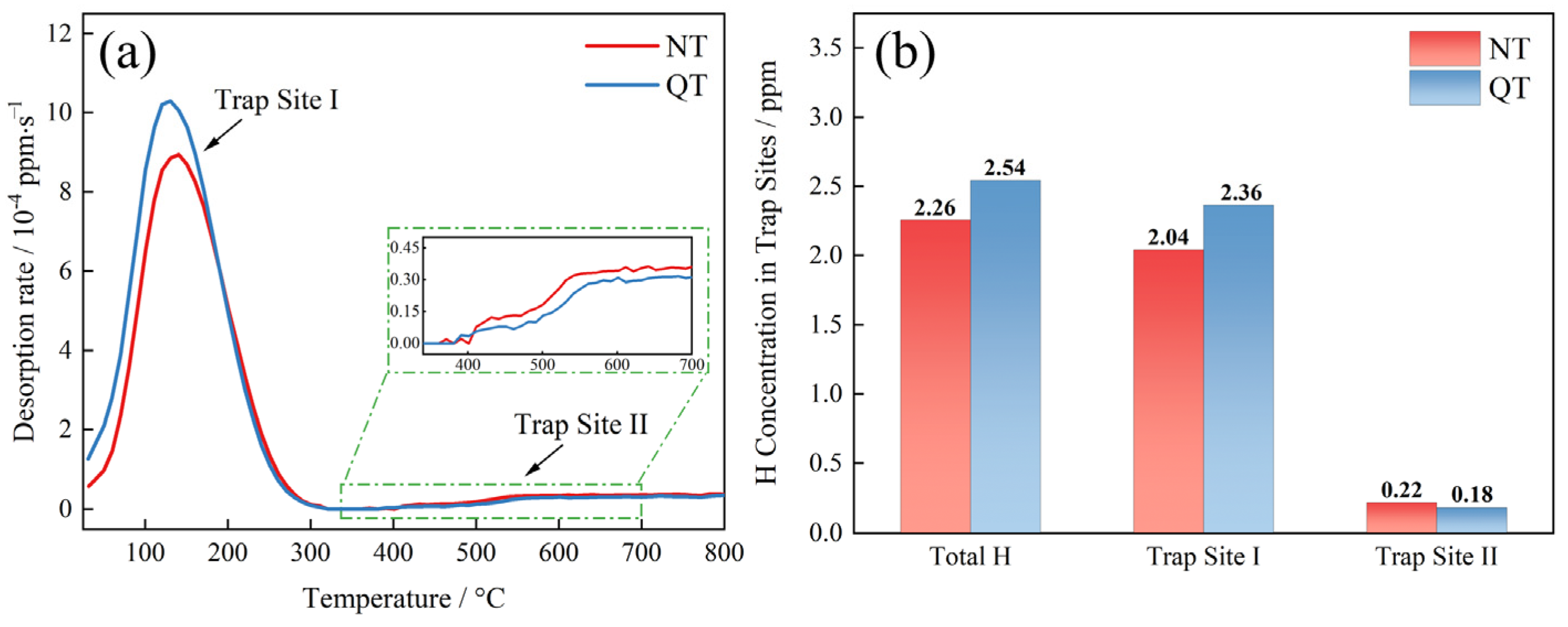
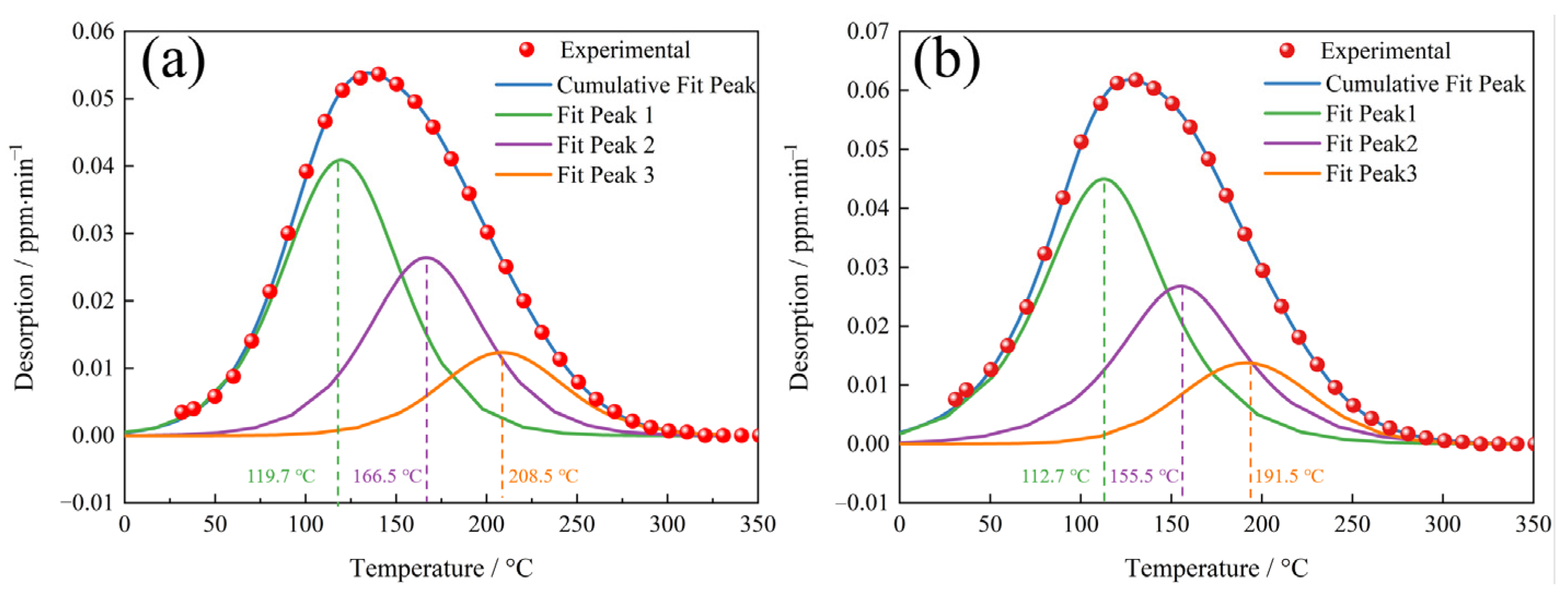


| C | Si | Mn | Cr | Ni | Mo | V | Ti | Cu | P | S | Fe |
|---|---|---|---|---|---|---|---|---|---|---|---|
| 0.30 | 0.25 | 0.85 | 0.90 | 1.65 | 0.25 | 0.08 | 0.005 | 0.188 | 0.0088 | 0.005 | Bal. |
| No. | L/cm | t0.63/s | Deff/10−7 cm2·s−1 | Capp/10−5 mol·cm3 |
|---|---|---|---|---|
| NT | 0.1283 | 28,336 | 0.968 | 2.09 |
| QT | 0.1275 | 14,385 | 1.880 | 2.51 |
| No. | Fit Peak 1 | Fit Peak 2 | Fit Peak 3 | Total H—Fitted | Total H—Measured |
|---|---|---|---|---|---|
| NT | 1.05 | 0.68 | 0.33 | 2.06 | 2.04 |
| QT | 1.22 | 0.76 | 0.38 | 2.36 | 2.36 |
| No. | ρmeanGND/m−2 | HAGBs/% | Dapp/×10−7 cm2·s−1 | IHE/% |
|---|---|---|---|---|
| NT | 9.84 | 11.70 | 0.968 | 66.80% |
| QT | 14.11 | 29.98 | 1.880 | 54.64% |
Disclaimer/Publisher’s Note: The statements, opinions and data contained in all publications are solely those of the individual author(s) and contributor(s) and not of MDPI and/or the editor(s). MDPI and/or the editor(s) disclaim responsibility for any injury to people or property resulting from any ideas, methods, instructions or products referred to in the content. |
© 2024 by the authors. Licensee MDPI, Basel, Switzerland. This article is an open access article distributed under the terms and conditions of the Creative Commons Attribution (CC BY) license (https://creativecommons.org/licenses/by/4.0/).
Share and Cite
Tong, Z.; Wang, H.; Zheng, W.; Zhou, H. Change in Hydrogen Trapping Characteristics and Influence on Hydrogen Embrittlement Sensitivity in a Medium-Carbon, High-Strength Steel: The Effects of Heat Treatments. Materials 2024, 17, 1854. https://doi.org/10.3390/ma17081854
Tong Z, Wang H, Zheng W, Zhou H. Change in Hydrogen Trapping Characteristics and Influence on Hydrogen Embrittlement Sensitivity in a Medium-Carbon, High-Strength Steel: The Effects of Heat Treatments. Materials. 2024; 17(8):1854. https://doi.org/10.3390/ma17081854
Chicago/Turabian StyleTong, Zhi, Hantong Wang, Wenyue Zheng, and Hongyu Zhou. 2024. "Change in Hydrogen Trapping Characteristics and Influence on Hydrogen Embrittlement Sensitivity in a Medium-Carbon, High-Strength Steel: The Effects of Heat Treatments" Materials 17, no. 8: 1854. https://doi.org/10.3390/ma17081854
APA StyleTong, Z., Wang, H., Zheng, W., & Zhou, H. (2024). Change in Hydrogen Trapping Characteristics and Influence on Hydrogen Embrittlement Sensitivity in a Medium-Carbon, High-Strength Steel: The Effects of Heat Treatments. Materials, 17(8), 1854. https://doi.org/10.3390/ma17081854






